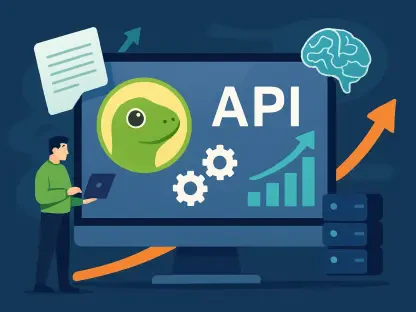Imagine a world where software doesn’t just respond to commands but anticipates needs, solves problems independently, and adapts to changing environments without constant human oversight. This is the promise of Agentic AI, a transformative branch of artificial intelligence that focuses on autonomy, decision-making, and goal-oriented behavior. As industries race to adopt smarter technologies, the demand for proactive applications has never been higher, pushing developers to explore innovative solutions.
Agentic AI stands out by enabling systems to act as virtual teammates, capable of perceiving challenges, reasoning through solutions, and executing actions with minimal intervention. Integrating this cutting-edge technology with .NET, a platform renowned for its robustness in enterprise and cloud-native development, offers a powerful synergy for building such intelligent systems. The framework’s structured environment and extensive tooling make it an ideal choice for crafting scalable and resilient AI solutions.
This guide aims to demystify the process of developing AI agents using .NET, covering essential concepts, practical implementation steps, and real-world applications. Key focus areas include understanding the foundations of Agentic AI, leveraging .NET for agent development, and exploring actionable strategies to create adaptive software. Readers will gain insights into harnessing this technology to stay ahead in a competitive landscape.
Why Choose Agentic AI in .NET Development?
In today’s fast-paced technological ecosystem, creating systems that merely react to inputs is no longer sufficient. Agentic AI empowers developers to build self-directed applications that can independently tackle complex tasks, making it a critical asset for staying competitive. By embedding such intelligence into software, businesses can achieve unprecedented levels of efficiency and innovation.
The integration of Agentic AI with .NET brings several compelling advantages. It enhances automation by enabling smarter decision-making within applications, supports scalability to handle dynamic workloads, and streamlines workflows through intelligent microservices. Additionally, this combination future-proofs systems by embedding autonomous capabilities that adapt to evolving user needs and market demands.
.NET’s structured framework, with its strong support for enterprise solutions, complements the development of AI agents exceptionally well. Its extensive libraries and tools facilitate seamless integration with advanced AI models, ensuring that developers can build robust and maintainable systems. This synergy positions .NET as a strategic platform for organizations aiming to leverage intelligent technologies for long-term success.
Step-by-Step Guide to Building AI Agents in .NET
Creating intelligent AI agents in .NET requires a systematic approach that blends cutting-edge AI concepts with the platform’s powerful capabilities. This section provides a detailed roadmap for developers, breaking down the process into manageable steps. From setting up the environment to implementing core functionalities, each phase is designed to ensure a solid foundation for autonomous systems.
The core technology stack for this endeavor includes .NET 7 or newer versions, the C# programming language for logic implementation, and the OpenAI SDK for integrating language model capabilities via NuGet packages. These tools collectively enable the creation of agents that can process natural language, make decisions, and execute actions. Understanding the fundamental components of Agentic AI—Perception, Reasoning, Action, and Learning—is crucial, as they directly map to specific development tasks within .NET.
By aligning these components with .NET’s architecture, developers can craft agents that perceive inputs through data collection, reason using language models, act via service integrations, and learn from interactions for continuous improvement. This structured methodology ensures that the resulting systems are not only functional but also capable of evolving over time to meet user expectations.
Setting Up the Development Environment
Initiating an AI agent project in .NET begins with establishing a suitable development environment tailored for intelligent applications. Start by creating a new console application using the .NET CLI or Visual Studio, ensuring the framework version is 7 or higher to leverage the latest features. This foundational setup provides a lightweight yet flexible base for experimentation and deployment.
Next, install essential packages such as the OpenAI SDK through NuGet Package Manager to enable communication with advanced language models like GPT. Configure project settings, including API keys and endpoints, within a file like appsettings.json to securely manage sensitive data. Properly organizing these elements ensures smooth integration and minimizes potential errors during development.
Real-World Example: Configuring a Customer Service Agent
To illustrate this setup, consider building a customer service AI agent within a console application. Structure the project with key files such as Program.cs for the entry point and dedicated classes like AgentService for handling core logic. This organization keeps the codebase modular, making it easier to expand functionalities like intent recognition or service routing as the project grows.
Designing the Agent Architecture
A well-thought-out architecture is vital for ensuring that an AI agent operates efficiently within a .NET application. Adopt a layered design comprising elements like Console UI for user interaction, Agent Service for decision-making, Router/Dispatcher for intent routing, Action Services for task execution, and an LLM Backend for natural language processing via OpenAI GPT. This separation of concerns enhances maintainability and scalability.
Integrating natural language processing with business logic allows the agent to interpret user intents accurately and trigger appropriate actions autonomously. For instance, the Agent Service can analyze input text using GPT models to determine user needs, while the Router directs these needs to relevant services. Such a design ensures that each component focuses on a specific role, optimizing overall system performance.
Case Study: Routing User Requests
Consider a scenario where a user queries, “Where is my order?” The AI agent, built on this architecture, processes the input through the Agent Service to identify the intent as an order status check. The Router then directs this intent to an OrderService, which retrieves the relevant data and formulates a response like, “Your order is in transit.” This example demonstrates how a layered approach enables precise and context-aware interactions.
Implementing Core Agent Functionalities
With the architecture in place, focus shifts to coding the agent’s core functionalities, starting with user input processing. Develop logic in C# to parse inputs via the Console UI and pass them to the Agent Service for intent analysis using the OpenAI SDK. This step ensures that the agent comprehends user requests accurately before proceeding to action planning.
Subsequent efforts involve implementing intent routing and action execution, where the Router dispatches tasks to appropriate Action Services such as OrderService or SupportService. Additionally, incorporate learning mechanisms by logging interactions in a LearningLogger class, enabling the agent to refine its behavior over time based on feedback and historical data. These features collectively empower the agent to handle tasks autonomously.
Practical Example: Handling Customer Scenarios
An interaction log can showcase the agent’s capabilities in real-time scenarios. For instance, when a user asks about order status, the agent responds with delivery details; for an address update, it confirms the change via CustomerService; and for login issues, it creates a support ticket through SupportService. These varied responses highlight the agent’s ability to make independent decisions tailored to specific user needs.
Testing and Iterating on Agent Performance
Ensuring the reliability of an AI agent demands rigorous testing within a controlled environment before deployment. Simulate user interactions to evaluate intent recognition accuracy and action execution effectiveness, using mock data to mimic real-world scenarios. This approach helps identify potential gaps in logic or response quality early in the development cycle.
Iterative development plays a pivotal role in enhancing agent performance. Continuously analyze interaction logs and user feedback to pinpoint areas for improvement, such as response clarity or decision accuracy. Adjusting algorithms and refining language model prompts based on these insights ensures that the agent becomes more adept at handling diverse queries over time.
Illustration: Refining Responses with Feedback
Take the example of initial responses to order status queries that users found vague or incomplete. By reviewing feedback, developers can adjust the agent’s phrasing to include specific details like estimated delivery dates, thereby increasing user satisfaction. This iterative process of testing and refinement is essential for delivering a polished and effective AI agent.
Conclusion and Recommendations for Adopting AI Agents in .NET
Reflecting on the journey of integrating Agentic AI with .NET, it becomes evident that this combination unlocks transformative potential for software development. The detailed exploration of building autonomous agents showcased how .NET’s robust ecosystem supports the creation of adaptive and intelligent systems. Each step, from setup to iteration, contributes to crafting solutions that proactively address user needs.
Looking ahead, developers and organizations should consider starting with small-scale implementations, such as customer service agents, to build confidence before tackling more complex challenges. Prioritizing data privacy and security, especially when leveraging external AI models, remains a critical focus throughout the process. Regularly updating systems to align with advancements in AI technology also proves essential for maintaining relevance.
Ultimately, the adoption of AI agents in .NET paves the way for innovation in automating workflows and enhancing user experiences. The next step involves exploring broader applications, such as integrating these agents into larger enterprise systems or combining them with emerging technologies for even greater impact. This path forward promises to redefine how intelligent software shapes business and user interactions.









